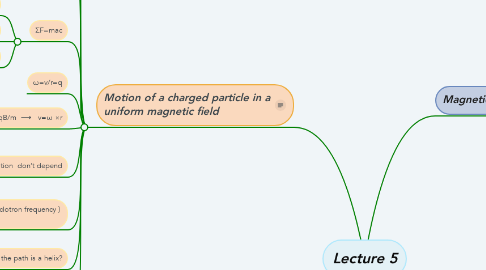
1. Magnetic Field
1.1. The electric force is independent of the velocity of the charge. Fe=qE
1.2. The magnetic force depends on the velocity of the charge. FB= qvB
1.2.1. (F is Perpendicular to both v and B)
1.3. F(e) has value if its direction is along E.
1.4. F(B) has value if its direction perpendicular B.
1.5. F(e) does work in displacing a charge particle.
1.6. F(B) does no work in displacing a charge particle, because the force is perpendicular to the displacement.
1.7. Magnetic field line point away from the north poles toward south poles.
1.8. F(B) depends on the velocity and magnitude and direction of the magnetic field.
1.9. When F(B) exerted on (+q) its direction is the opposite to B direction.
1.10. When F(B) exerted on (-q) its direction is the same as B direction.
1.11. if the angle between V and B is (0,180) F(B)= 0
1.12. if the angle between V and B is (90) F(B)= maximum.
2. Magnetic force acting on a current carrying conductor
2.1. Total magnetic force : FB=(qvdxB)nAL
2.2. Wire current I=nqvd A the force : FB=ILxB Where L is a vector that the point in the direction of the current I and has a magnetiud equal to the length L of the segment.
2.3. To calculate the total force FB acting on the wire. we integrate Equation 29.4 over the length of the wire: FB=I∫ds×B
2.4. Case1. A curved wire carries a current I and is located in a uniform magnetic field B, as shown in Figure 29.10a. Because the ficld is uniform, we can take B outside the integral in Equation 29.5, and we obtain FB=I(∫ds)×B
2.5. But the quantity ds represents the swtor sum of all the length elements from a to k From the law of vector addition, the sum equals the vector L', directed from a to k. Therefore, Equation 29.6 reduces to FB=IL'xB
2.6. From this we conclude that the magnetic force on a curved current-carrying wire in a uniform magnetic field is equal to that on a straight wire connecting the end points and carrying the same current.
2.7. Case 2. An arbitrarily shaped closed loop carrying a current I is placed in a uniform magnetic field, as shown in Figure 29.10b. We can again express the magnetic force acting on the loop in the form of Equation 29.6, but this time we must take the vector sum of the length elements ds over the entire loop: FB=I(∮ds)×B
2.8. Because the set of length elements forms a closed polygon, the vector sum must be zero. This follows from the procedure for adding vectors by the graphical method. Because ∮ ds = 0, we conclude that Fg = 0; that is, the net magnetic force acting on any closed current loop in a uniform magnetic field is zero.
3. Motion of a charged particle in a uniform magnetic field
3.1. If the force is always perpendicular to the velocity, the path of the particle is a circle.
3.2. When the particle moves in a circle?
3.2.1. magnetic force Fn perpendicular to v and B, and has constant magnitude qvB.
3.3. Rotation
3.3.1. Rotation is counterclockwise.
3.3.2. Rotation is clockwise.
3.3.3. For a positive charge.
3.3.4. For a negative charge.
3.4. ΣF=mac
3.4.1. qνB = (mν^2)/r
3.4.2. (qνB)(r) = mν^2 dividing two side qνB
3.4.3. r= (mν^2)/qνB = mv/qB
3.5. ω=v/r=q
3.6. ω= v/r = qB/m ⟶ v=ω ×r
3.6.1. T = 2πr/v = 2πr/(ω ×r)= 2π/ω ⟶ = 2πm/qB
3.6.1.1. Period of motion proportional to the mass, And inversely proportional magnitude of the charge and magnetic field.
3.7. Angular speed of the particle and period of the circular motion don’t depend
3.7.1. on the liner speed of the particle.
3.7.2. On the radius of the orbit.
3.8. the name other of Angular speed of the particle (cyclotron frequency ) why?
3.8.1. because charged particle circular at this angular frequency in the type of accelerator called a cyclotron.
3.9. when the path is a helix?
3.9.1. If charged particle moves in a uniform magnetic field with its velocity at some arbitrary angle with respect to B.
3.10. Application involving charged particles moving in a magnetic field
3.10.1. Magnetic mirror.
3.10.2. Velocity selector.
3.10.3. The mass spectrometer.
3.10.4. The cyclotron.
4. Magnetic Field and Forces
4.1. For a moving charge Q in the presence of both electric and magnetic fieldsis given by : 𝐹 = 𝑄 (𝐸 + 𝑢 × 𝐵)
4.2. If the mass of the charged particle moving in 𝐸 and B 𝐹 = 𝑚 𝑑𝑢 / 𝑑𝑡 = 𝑄 (𝐸 + 𝑢 × B)
4.3. The force on a current element 𝐼𝑑𝑙 in a magnetic field B is 𝑑𝐹 = 𝐼𝑑𝑙 × B
4.4. if the current 𝐼 is through a closed path 𝐿 or circuit
4.4.1. F=∮Idl×B
4.5. If we have surface current element 𝐾𝑑𝑆:
4.5.1. F=∮s Kds×B
4.6. If we have volume current element 𝐽𝑑𝑣:
4.6.1. F=∮vJdv×B
